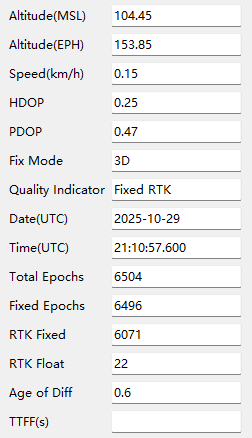Hi All,
I have searched the GPS/GNSS Forum for an answer to my issue and have not able to find a solution.
Base Station: Sparkfun RTK Postcard/Portability Shield with L1/L2/L5 active antenna.
ZED-F9P UART3 RTCM3 Telemetry baud rate of 57,600.
Rover 1: Sparkfun ZED-F9P RTK Receiver with L1/L2 active antenna .
Rover 2: Sparkfun LG290P RTK GNSS Breakout Module L1/L2 active antenna.
LG290P GNSS RTK Breakout Module FW: LG290P03AANR01A05S
The baud rate for the LG290P RTCM3 Telemetry UART3 input is 57,600.
I decided to evaluate my Sparkfun RTK Postcard Base Station with the Sparkfun LG290P RTK GNSS Development Module that I plan to install on my Traxxas Rover.
I setup the RTK Postcard/Portability Shield Base Station in the driveway with a clear view of the sky, got a mean deviation of under 0.3 m after a 60 sec Survey-in, after which the RTCM3 transmissions began.
Then I powered up the Sparkfun ZED-F9P RTK Receiver that is presently on my Traxxas Rover, which had a clear view of the sky, and after less than five minutes I had a RTK Fix indication when the board RTK indicator quit flashing.
So I swapped out the ZED-F9P RTK Receiver with the Sparkfun LG290P RTK GNSS Breakout Module and could only get a RTK Float indication as the board RTK indicator kept flashing and never turned off to indicate a RTK Fix indication.
To verify this issue with the LG290P RTK GNSS Development Module, I took the LG290P RTK GNSS Development Module off the Traxxas Rover and hooked it up to a laptop outdoors and used the Quectel QGNSS app to verify that the LG290P RTK GNSS Development Module on the Rover was only getting a RTK Float indication, not a RTK Fix indication, and that was the case as the QGNSS Data View Quality Indicator was showing “Float RTK”.
Since my Sparkfun ZED-F9P RTK Receiver was able to reach RTK Fix using the same Sparkfun RTK Postcard/Portability Shield Base Station I am confident that the same RTCM3 messages should be being received by the LG290P RTK GNSS Development Module too.
Therefore I am presently at a loss as to how to troubleshoot this issue as it looks like I have the latest stable LG290P software version according to the Sparkfun GitHub.
Regards,
TCIII








